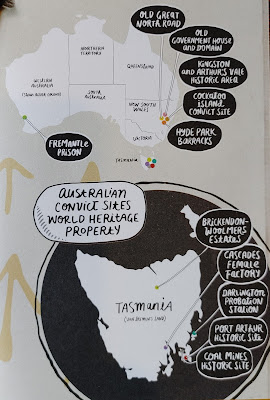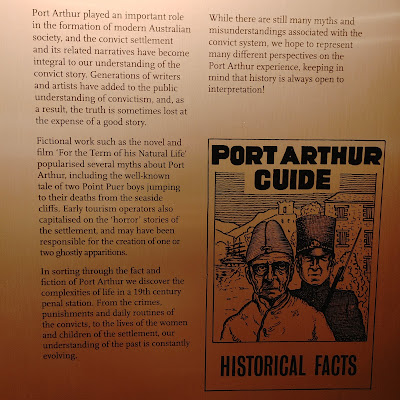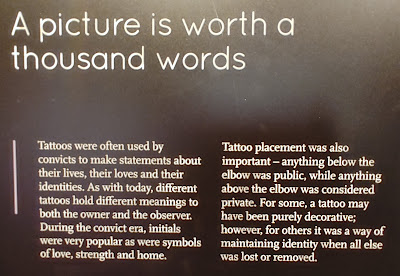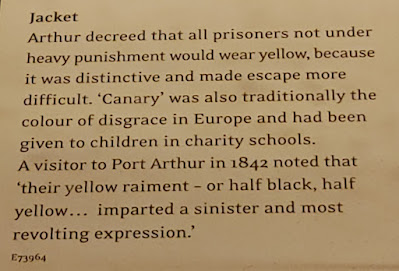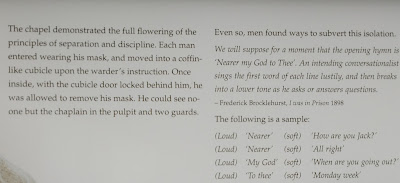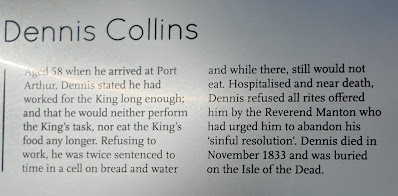 |
| There's a lot of interesting information at the following site: History Timeline - Port Arthur Historic Site |

 |
| A map of a site always helps me understand what I am seeing so here's the legend with the map on the following two posts. |
 |
| Click to enlarge so you can read the numbers assigned to each location. |
 |
| The saddest thing I saw while visiting this site. |
 |
| At the visitor center we were each given a card. |
 |
| We matched this card to the matching drawer within the museum to learn about the person we had been assigned. |

 |
| My sister's card with the booklet we were given |
 |
| View of the site from the air |
 |
| Token under a magnifying glass |
 |
| Although hard to read, this display shows existing buildings in white with the outlines of other buildings that existed during the convict years. Although it took 8 hours to sail from Hobart to Port Arthur, the use of semaphores cut the time to relay messages to 15 minutes! |
 |
| Separated by trees on the left, is the Commandant's House. |
 |
| Looking over the penitentiary and up the hill to the remains of the hospital. Doctors examined the convicts each week. |
 |
| As always, wikipedia has a lot more information on the site. |
 |
| Very interesting flowering tree. It's a datura, also called Devil's Trumpet due to its shape and highly poisonous nature. |
 |
| I didn't get a photo of this one as the view of it is mostly obscured by trees. |
 |
| Roman Catholic Chaplain's House. Male convicts took care of the gardens. Female convicts taught the children and cleaned the homes. |
 |
| The Junior Medical Officer's House was open |
 |
| Upon entering the Junior Medical Officer's House. |
 |
| What!? They raised 12 kids in this house? I thought my childhood bedroom was crowded when I had to share a very small room with one sister. |
 |
| The Asylum and Separate Prison. Notice the line of trees in front of the buildings. |
 |
| Section of trunk from one of the original trees. |
 |
| Masked lapwings were nesting in the mulch alongside the Memorial Avenue. We were warned that they might swoop at us. None did that to me, but they sure did make a lot of noise. |
 |
| The Asylum was the last major building to be built during the convict era. When Port Arthur shut down in 1877, people started coming to see the site. Tourists took a lot of stuff. |
 |
| Originally Port Arthur's violent lunatics were housed in the Separate Prison |
 |
| The site's commandant was more concerned with management than with treatment. If the prisoners continued to behave in a disorderly manner, staff resorted to punishment. |
 |
| Back side of the Separate Prison. |
 |
| The tours didn't go inside the buildings, but our guide said the guards at the Separate Prison wore felt slippers. |
 |
| Prisoners lived a very regimented life. |
 |
| Each cell had a number and a bell |
 |
| Love the stories of the individuals who had occupied Port Arthur. |
 |
| There's not much left of the church, which was the first major building built at Port Arthur. |
 |
| Government Gardens |
 |
| Almost bought this dish towel with all the different Tasmanian animals on it. |
 |
| 1996 Memorial Garden entrance |
 |
| Can't believe someone would want to live surrounded by this historic monument with all the visitors going past every day. |
 |
| A cruise of the bay is included in the price of admission |
 |
| The tour was conducted on a walkway since there are unmarked convict burial sites dotting the island. |
 |
| Convicts were buried in unmarked mass graves on the lower part of the island. Of the more than 1,600 known graves on the island, only 180 graves have headstones. |
 |
| Burials of civilians, military officers, their wives and childen were on the higher part of the island. The following website has more information on the island. The Isle of the Dead - Tasmanian Times |
 |
| If I remember correctly, this headstone marks the graves of two people, one a free person and one a convict. |
 |
| Our tour guide told us the history of some of the people buried here. Unfortunately, due to the limitations of medical care at the time, many were young women who died during childbirth and children. |
 |
| This marker started out as the headstone on the grave of a two-year old. But unfortunately, the family lost two more children - a 5-month-old and an 18-year-old. |
 |
| I was surprised by the rhododendron but I found out there are over 1,000 species and some are native to Australia. We have many bushes in our yard in Oregon. |
 |
| As we reboarded the boat, we could see most of the historic site across the water. |
 |
| We could also see the town of Port Arthur. |
 |
| The flour mill/penitentiary. |
 |
| Another plant we have in our yard in Oregon, pieris japonica. It's native to eastern China, Taiwan, and Japan |
 |
| This and the next photo are of the historic site from the motel. |


